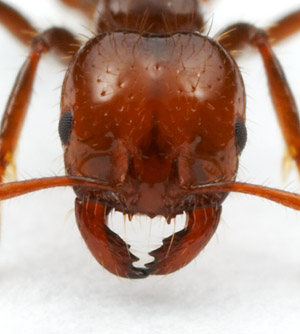
In case you were wondering, ants turn out to be ambidextrous.
Instead of favoring one side or the other as we humans do with our hands, ants show no preference for working with either mandible. That's the conclusion of a new study by Cassill & Singh:
Abstract: The elongation and sharp teeth of ant mandibles are considered important adaptations that have contributed to ants successful colonization of terrestrial habitats worldwide. In extant ant species, mandibles function as hunting and defense weapons, as well as multipurpose tools for excavating soil, cutting leaves, capturing and butchering prey, harvesting seeds, and transporting brood. This article reports that the mandibles in the red imported fire ant, Solenopsis invicta Buren, are functionally ambidextrous. Individuals opened and closed each mandible in synchrony or independently depending on the requirement of the task at hand. Upon completion of a task, individuals were without a preference in the orientation of mandible overlapâright overlap or left overlap. Orientation of mandible overlap before and after performing a task was also examined in nine other ant species. No overlap orientation preference was observed in any of these ant species, suggesting that ambidextrous mandibles are a universal trait in ants. These findings add an increment of knowledge to the diverse functions of ant mandibles.

Doesn't this imply that ants would be using one side of their brain more than the other? Do insects even have a creative and logical side to the brain? Isn't it all just Sugar to them?
The mandibles aren't left or right handed, but they may be chiral in which slides dorsal to the other while chomping. I see it in other insects.
I, as a worker ant, am right handed!
To my mentor Dr. Deby Cassill:
Thank you for giving me the opportunity to do research under you. I wish you best in your future work.